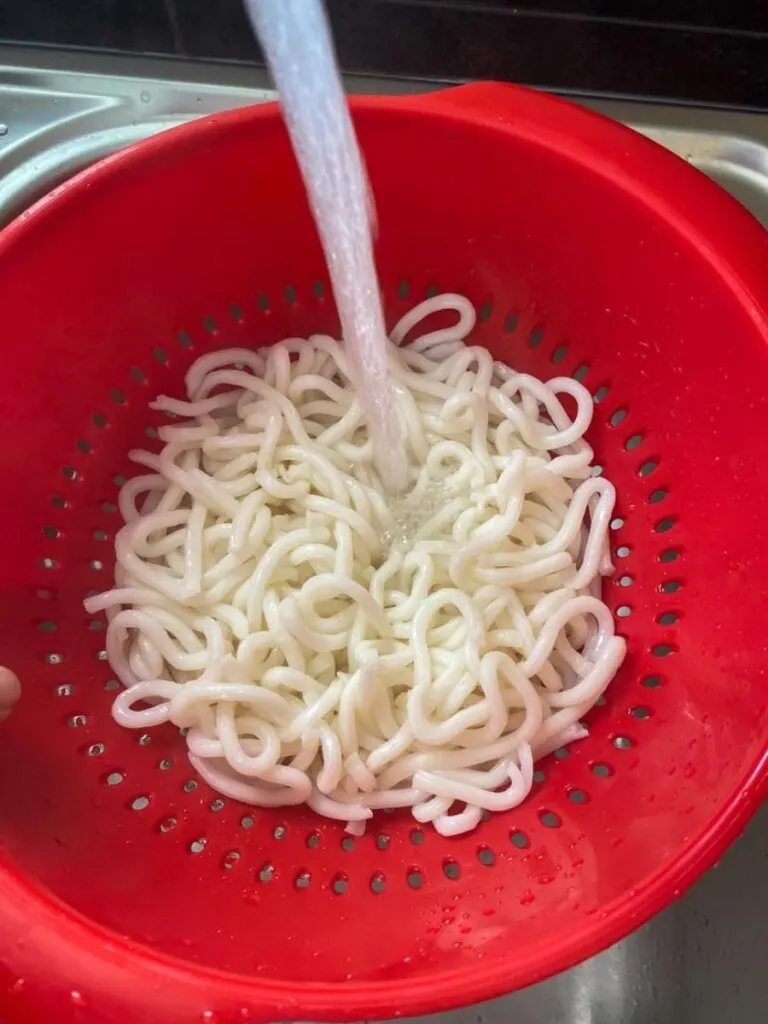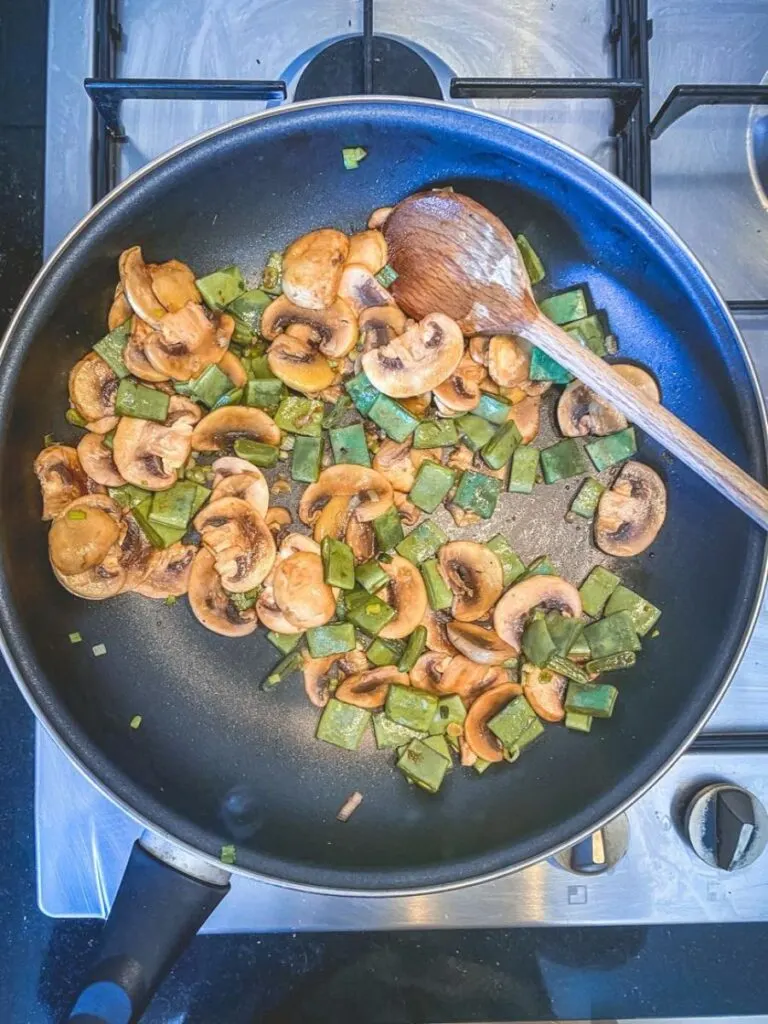Stir fry udon noodles are a delicious and easy-to-make main dish that I love and often prepare.
A big hit always!

This sauteed udon noodles combines the chewy texture of udon noodles with the bold flavors of sweet chili and garlic, making it a delicious and satisfying option for lunch or dinner.
TABLE OF CONTENTS
Why you’ll love this quick and easy udon noodles recipe!
Easy recipe: Preparing these udon is really easy and only a few ingredients are needed.
Quick meals: Udon noodles cook relatively quickly, making them a convenient option for a quick and tasty meal.
This stir-fry udon noodle recipe took less on 15 min to cook!
Customise: Udon noodles are very versatile and can be combined with a variety of ingredients and sauce.
This means you can customise the recipe to match your preferences or the ingredients you have on hand.
Delicious: Udon noodles have a thick, chewy texture that gives a satisfying bite.
What are Udon noodles?
Udon noodles are a thick Japanese noodles.
They are made of wheat flour, water and salt. Udon noodles have a chewy, slightly slippery texture and are typically white or light beige in color.
One of the distinguishing characteristics of udon noodles is their thickness.
They are much thicker than other Japanese noodles such as soba or ramen, which gives them a chewy, hearty quality.
Stir Fry Udon Noodles Ingredients

Udon Noodles: You can use fresh, packaged udon noodles or frozen udon noodles.
All will work for this recipe! I use packaged ones.
Sweet Chilli Sauce: It provides the perfect balance of flavours.
You can pre-prepare it at home or you can find it in the Asian section of your supermarket.
Garlic: Fresh garlic is best for this recipe, but if you prefer a less strong taste you can use garlic powder.
Vegetables: Various vegetables can be used for stir-fried udon noodles.
I used mushrooms, green onions and flat beans.
Vegetable oil: We need very little of it, its for stir fry the garlic and vegetables.
Types Of Udon Noodles To Use
Fresh noodles: Fresh udon noodles are usually found in the refrigerated section of Asian grocery stores. Fresh udon noodles are ideal for making hot udon noodle soup.
They cook quickly and retain their springy texture.
Packaged udon noodles: Where I live they are the easiest to find, they are usually pre-cooked.
I always recommend putting them in hot water for a minute to separate them properly.
Frozen udon noodles: The are similar to fresh udon noodles in terms of texture and flavour.
Freezing helps preserve their freshness and they can be cooked by boiling them directly from frozen.
Dry udon noodles: These types of udon noodles are cooked before adding them to the recipe to rehydrate them.
How to make Udon Noodle Step By Step
Prepare udon noodles: To prepare the udon noodles, soak them in hot water for about a minute and use a pair of chopsticks to carefully break them apart (always check the instructions on the packet).
Once the noodles are separated, drain them and rinse them under cold water to stop the cooking process. This will prevent the noodles from becoming mushy.

Prepare the vegetables: Start by mincing one garlic and slicing the spring onions, separating the white part from the green part.
Wash the mushrooms and green beans under running water and slice them.
Start stir-frying : Heat a wok or large pan over high heat and add a little oil.
Once the oil is hot, add the garlic and the white part of the spring onion and brown them.
Add the vegetables and fry them for 3-4 minutes until cooked through.

Add the cooked udon noodles and sweet chilli sauce and toss everything together until the sauce coats the noodles and vegetables.

If the sauce is too thick, you can add a little water to thin it out.
Turn off the heat and last add the green part of the spring onion for a fresh touch.

Best Tips For udon stir fry
- Make sure your frying pan is hot enough before you start cooking the vegetables.
This will ensure that your ingredients cook evenly and quickly, without becoming soggy.
- Don’t overcrowd the pan.
If you add too many ingredients at once, they will release too much moisture and steam instead of getting that nice sear and char that gives stir-fry its distinctive flavor.
- Be careful not to overcook the noodles.
They need only one minute in hot water to separate them, then immediately run them under cold water to stop the cooking.
What to serve with Stir Fry Udon Noodles
This vegetarian udon noodle recipe is delicious on its own, but you can also serve it with some additional side dishes to make it a complete meal.
I love to serve homemade dumplings, spring rolls or Vietnamese egg rolls to accompany the noodles, a great option could be vegetables such as broccoli, carrots or snow peas.
Substitutions
Use your favorite protein: For example, add some chicken, shrimp, or tofu to the stir fry, for a more hearty meal.
Cook protein before vegetables, as cooking times are longer.
Or have you thought about putting air fryer poached eggs on top?!
- Switch up the vegetables: Try different vegetables such as bell pepper, bok choy, shiitake mushrooms, baby corn or broccoli.
- Try different stir fry sauce: Try different sauce like regular soy sauce or dark soy sauce, chow mein or teriyaki sauce are delicious with udon noodles.
- Try different noodle for stir fry: Rice Noodles, soba noodles or Vermicelli Noodles are a great choice for stir-frying.
How To Store And Reheat Udon
Store: After letting them cool down transfer your noodles and vegetables into an airtight container and refrigerate them for up to 4 days.
Reheat: Add a splash of water or broth to prevent the noodles from sticking together.
You can microwave your noodles in a microwave-safe bowl, or heat them up in a pan on medium-high heat.
Make sure to stir frequently and cook until heated all the way through.
FAQ’s
Udon noodles are made from wheat flour and water, which makes them a good source of carbohydrates. When paired with vegetables and a flavorful sauce like the one in this recipe, udon noodles can be a healthy and satisfying meal.
Yes, I have found that udon noodles are perfect for stir fry, the important thing is to be careful not to overcook them during boiling.
No, they contain gluten, Try using soba noodles that are gluten-free.
Udon noodles need to be cooked for 1-2 minutes in boiling water before they are ready to use in stir-fry dishes. They should be tender and chewy, but not mushy.
Boil. Hot water is the best way to separate them.
Rinsing udon noodles might seem like an extra step, but it’s actually a crucial one for achieving the perfect texture. By rinsing the noodles under cold water after cooking, you remove any excess starch and and stop cooking process.
The chewiness is given to a low water-to-flour ratio..Additionally, udon noodles are kneaded for a longer time than other types of noodles, which also contributes to their chewiness.
Udon Noodle Stir Fry Recipe

CONNECT WITH THE BELLA VITA!
Be sure to follow me on social media, so you never miss a post!
Vegetarian Stir Fry Udon Noodles

This vegetarian stir fry udon noodles with sweet chili sauce recipe is perfect for a quick and healthy dinner.
Ingredients
- 1 tablespoon vegetable oil ( sesame oil or avocado)
- 2 Spring onion
- 1 garlic clove, minced
- 1/2 cup sliced mushrooms
- 1/2 cup of flat bean, cutted
- 14 oz udon noodles
- 1 cup sweet chili sauce
- Black pepper to taste
Instructions
- Cook udon noodles according to package instructions. I used packaged udon noodles, so I put them in hot water for a minute to separate them well, drain in cold water and set aside.
- Heat oil in a large skillet pan over high heat.
- Add garlic and the white part of the spring onion and stir-fry for 10 seconds.
- Add mushrooms and flat beans. Stir-fry for 3-4 minutes until vegetables are slightly tender.
- Add the cooked udon noodles, and the sauce.
- Stir-fry for another 2-3 minutes until everything is evenly combined.
- Add the green part of the spring onion and serve.
Nutrition Information:
Yield:
2Serving Size:
1Amount Per Serving: Calories: 565Total Fat: 8gSaturated Fat: 1gTrans Fat: 0gUnsaturated Fat: 7gCholesterol: 0mgSodium: 45mgCarbohydrates: 115gFiber: 6gSugar: 70gProtein: 11g
Nutrition is automatically calculated by Nutritionix - please verify all nutrition information independently and consult with a doctor or nutritionist for any and all medical and diet advice.
